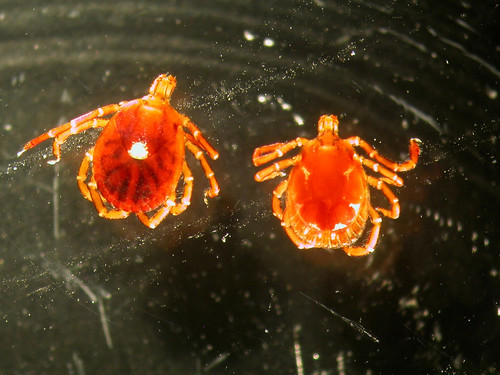March 3, 2017
Ticks become active as temperatures warm
By Fred Miller
U of A System Division of Agriculture
(546 words)
FAYETTEVILLE, Ark. -- With the warmer temperatures in February, we are seeing an earlier occurrence of ticks. Throughout much of February, I’ve picked up a few adult lone star ticks (Amblyomma americanum). Tick species that survive winters in leaf litter, soil or other protected areas will become active and search for a host when temperatures warm. Tick abundance is influenced by habitat type, environmental conditions and availability if suitable hosts.
Arkansas is home to several tick species and multiple tick-borne diseases occur here.
The Arkansas Department of Health recently issued a news release indicating that two individuals met CDC’s surveillance definition for Lyme disease. The last case that met CDC’s definition for Lyme was in 2007. These recent cases are not too surprising. In 2012, University of Arkansas researchers identified (in low frequency) the spirochete (Borrelia burgdoferi) that causes Lyme disease in dogs, deer and in the potential tick vector (black-legged tick - Ixodes scapularis).
Most of our important tick species are three host ticks.
This means that each stage (larva, nymph and adult) feeds on a different host. This is an important factor in tick-borne disease transmission because the pathogen that causes disease is usually acquired by a previous stage feeding on an infected host. Each tick stage is fairly distinctive. The larval tick is the tiny six-legged tick known by many as the “seed” tick. The tick nymph is the stage following the larval stage and is small (but bigger than the “seed’ tick) and has eight legs. The nymph may also be referred to as the “yearling” tick. The adult tick is obviously larger than the nymph, has eight legs and is the reproductive stage.
Below are some tips to avoid tick bites and potential disease exposure.
- AVOID tick hideouts such as wooded, brushy areas.
- IF YOU’RE IN tick territory: Wear light-colored clothing, long-sleeved shirts, long pants tucked into boots. Walk in the center of wooded trials.
- USE skin-safe repellents containing DEET, picaridin, oil of lemon eucalyptus or IR3535.
- USE clothing- and gear-only repellents containing permethrin – Repel Permanone or Sawyer gear and clothing repellent.
- ONCE INSIDE, check your entire body for ticks – parents should carefully inspect their children. Promptly, properly remove attached ticks.
- TICKS DIE quicker in dry environments, so remove leaf litter, keep lawn mowed, clear tall grass. Create a dry barrier between lawn and woods by laying gravel or wood chips.
- CLEAN UP food, wood piles to discourage tick-carrying wild animals from yard, use tick control on pets.
- CONSIDER chemical control in tick-infested yards.
Proper tick removal
- USING sterilized tweezer, grasp the tick as close as possible to skin.
- PULL upward with steady pressure, not jerking or twisting the tick. If mouthparts remain in the skin, remove them with sterilized tweezer.
- AFTER removing the tick, thoroughly clean the bite area and your hands with rubbing alcohol, an iodine scrub, or soap and water.
- RECORD the date of the tick bite.
- DISPOSE of a live tick by submersing it in alcohol, placing it in a sealed bag/container or flushing it down the toilet.
- Removed ticks can also be preserved in a vial with alcohol. Do not crush a tick with your fingers.
- WRITE down the date the tick was removed.
UAMS conduct tick study
Meanwhile, the University of Arkansas for Medical Sciences is asking for the public's help in its study of ticks. (See: http://katv.com/community/7-on-your-side/uams-tick-study-needs-you )
To learn more about safely enjoying the outdoors, contact your local Cooperative Extension Service Agent or visit www.uaex.uada.edu.
Pursuant to 7 CFR § 15.3, the University of Arkansas System Division of Agriculture offers all its Extension and Research programs and services (including employment) without regard to race, color, sex, national origin, religion, age, disability, marital or veteran status, genetic information, sexual preference, pregnancy or any other legally protected status, and is an equal opportunity institution.
# # #
Media Contact: Mary Hightower
Dir. of Communication Services
U of A Division of Agriculture
Cooperative Extension Service
(501) 671-2126
mhightower@uada.edu
Related Links
